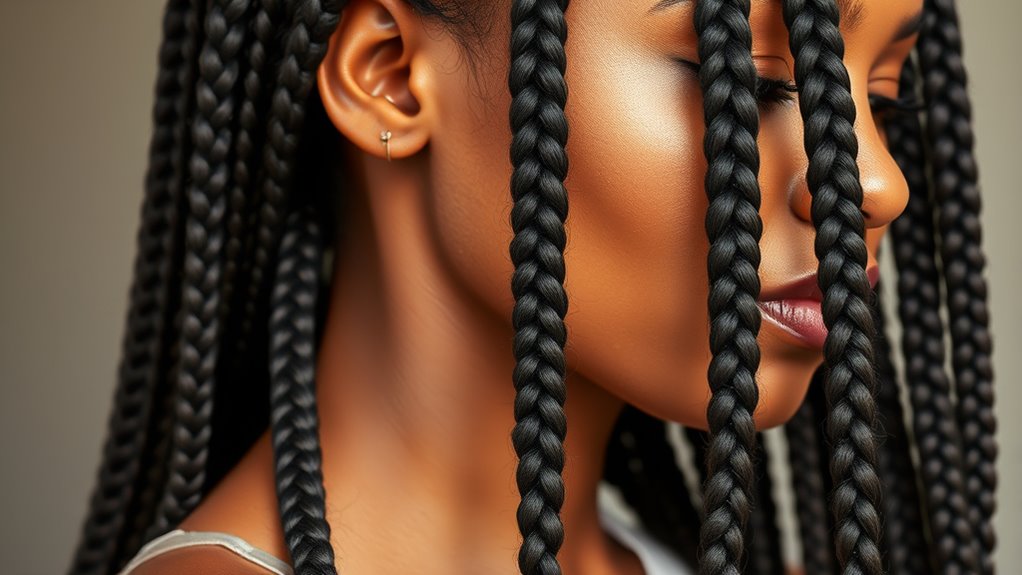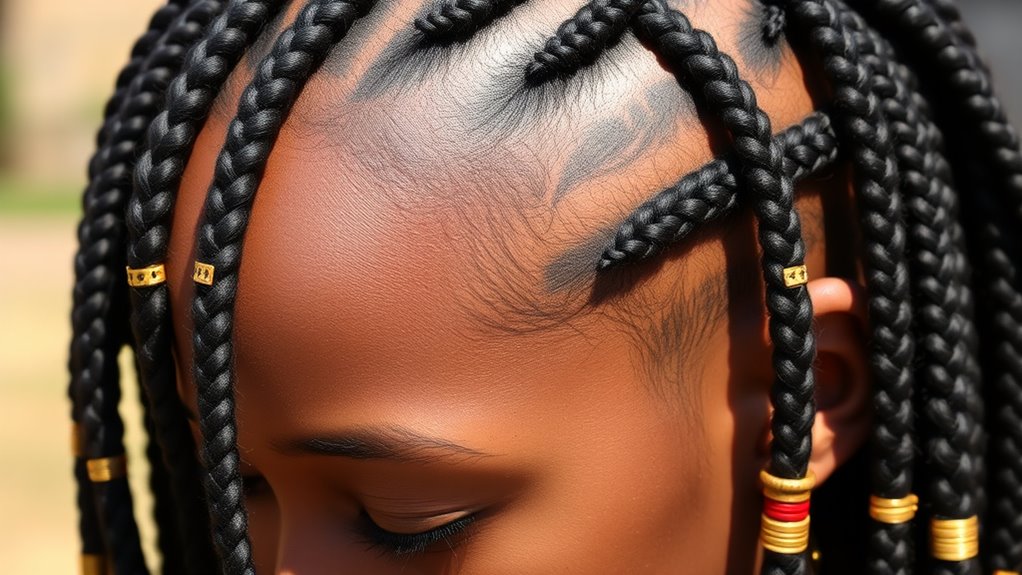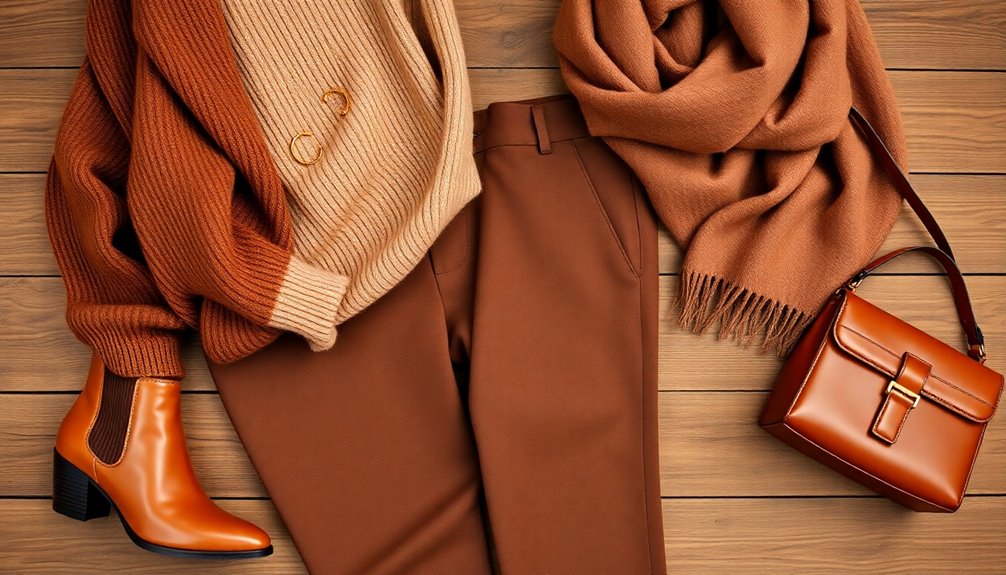Protective styles are haircare methods that shield your natural hair from damage by reducing manipulation and environmental stressors, helping promote growth and maintain overall health. They include styles like braids, twists, and weaves that keep your ends tucked away and minimize breakage. Proper techniques, such as avoiding tight styles and keeping your scalp moisturized, enhance their benefits. Continuing will reveal more tips on how to make the most of protective styling for healthy hair.
Key Takeaways
- Protective styles shield hair ends and reduce manipulation, promoting healthier growth and minimizing damage.
- They help prevent issues like breakage and traction alopecia by protecting hair from environmental stressors.
- Proper techniques, such as gentle braiding and scalp moisturization, enhance the benefits of protective styles.
- Regular breaks and proper care maintain scalp health, prevent tension, and support long-term hair growth.
- Using reputable hair care practices ensures maximum benefits from protective styling and overall hair health.

Protective styles are a popular way to safeguard your natural hair while promoting growth and reducing damage. By choosing styles that protect the ends and minimize manipulation, you give your hair the chance to grow stronger and healthier. One key aspect of successful protective styling is mastering the right braiding techniques. Whether you opt for box braids, twists, or feed-in braids, using proper braiding techniques ensures your hair remains secure without causing unnecessary tension or breakage. When installing these styles, make sure your hair is clean, moisturized, and detangled, which makes braiding easier and helps prevent damage. Incorporate hair growth tips like keeping your scalp moisturized, avoiding tight braids, and giving your hair regular breaks from styling. These habits support healthy growth and prevent issues like traction alopecia.
As you explore different protective styles, understanding how to properly braid your hair becomes essential. Techniques such as sectioning your hair neatly, avoiding overly tight braids, and using smooth, even braiding methods help reduce stress on your scalp. When braiding, keep tension consistent to prevent pulling on your roots, which can lead to hair loss over time. If you’re new to braiding techniques, consider taking the time to learn from tutorials or professionals to perfect your skills. This investment can make a significant difference in how your hair responds to protective styling and how well it maintains its health. Additionally, rotating between different styles gives your scalp a break from constant tension, ultimately promoting better hair growth.
Furthermore, understanding the importance of well-sourced name coverage can help you identify reputable sources for hair care information and avoid misinformation. Alongside mastering braiding techniques, adopting hair growth tips while in protective styles ensures you maximize their benefits. Regularly moisturizing your scalp and hair helps prevent dryness and breakage. Using lightweight oils or leave-in conditioners can keep your hair flexible and less prone to snapping. You should also pay attention to your hair’s overall health by trimming split ends and avoiding styles that are too tight, especially around the edges. Giving your hair periodic breaks from styling can help prevent stress on the hair follicles and scalp, which is crucial for long-term growth. Remember, protective styles aren’t just about looking good—they’re about nurturing your hair and scalp to achieve ideal growth and strength.
Frequently Asked Questions
How Long Can Protective Styles Typically Last?
You can typically keep protective styles in for 4 to 8 weeks, depending on hair retention and styling versatility. Proper maintenance helps prevent damage and keeps your hair healthy longer. If you notice any discomfort or excessive shedding, it’s best to remove or redo the style sooner. Regular care, including moisturizing and gentle handling, guarantees your protective style stays beautiful and your hair stays strong during its wear time.
Are Protective Styles Suitable for All Hair Types?
Protective styles can be suitable for many hair types, but your hair type compatibility influences how well they work for you. If you have curly, coily, or straight hair, you’ll find some styles more beneficial than others. They also offer great styling versatility, allowing you to switch up your look while protecting your natural hair. Just choose styles that suit your hair texture and needs for the best results.
Can Protective Styles Cause Hair Damage?
Protective styles can cause hair damage if you don’t avoid hair breakage or scalp tension. Tight styles pull on your roots, risking breakage, and prolonged tension can weaken hair strands. To prevent this, don’t keep styles in too long, choose gentle techniques, and give your scalp regular breaks. When done correctly, protective styles support your hair’s health without causing damage. Always listen to your hair’s needs and adjust accordingly.
How Often Should I Wash My Hair in a Protective Style?
You should wash your hair every 1 to 2 weeks while in a protective style to maintain good hair health. Incorporate proper hair maintenance routines, like gentle cleansing and moisturizing, to prevent buildup and dryness. Use styling tips such as avoiding harsh shampoos and detangling carefully. This helps keep your scalp clean and your hair moisturized, ensuring your protective style stays fresh and your hair stays healthy.
Do Protective Styles Promote Hair Growth?
Absolutely, protective styles can promote hair growth when done right. Think of it like a Robin Hood’s arrow—focused and purposeful. They help by maintaining hair moisture and improving scalp health, which are key for growth. When you keep your scalp clean and moisturized, your hair can thrive beneath the style. Just be sure not to leave protective styles in too long, as that can lead to damage instead of growth.
Conclusion
Protective styles are your secret weapon for maintaining healthy hair while trying new looks. They shield your strands from damage, promote growth, and give you a break from daily styling. Remember, even the best defenses need care—don’t let your style become a double-edged sword. With patience and proper maintenance, these styles can work wonders. Keep your eye on the prize, because in the end, healthy hair is worth its weight in gold.










